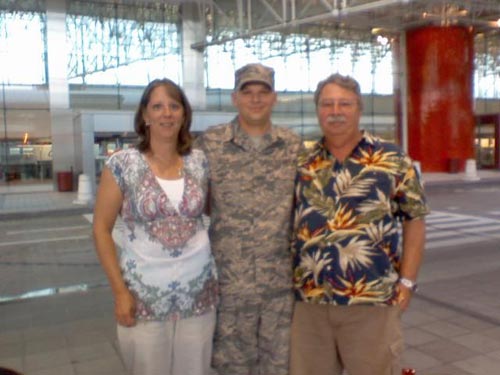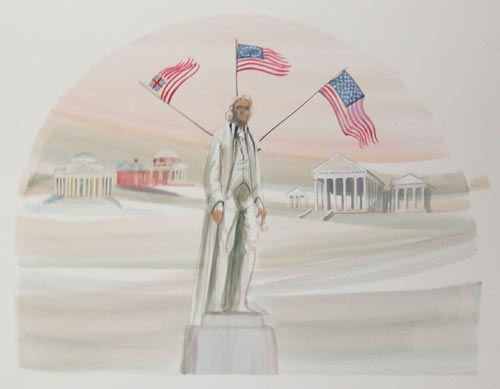Send this e-mail letter to a friend:
Dear Friends:
Happy birthday, USA! Our great nation turns 232 years young this Friday, July 4. Our Constitution is the world’s oldest federal constitution, and in its over two hundred-year history it has only been amended twenty-seven times. The first ten amendments, as we all know, are the Bill of Rights. The Constitution is actually younger than our country. It was adopted on September 17, 1787, by the Constitutional Convention in Philadelphia, Pennsylvania, and later ratified by conventions in each state. It replaced the Articles of Confederation as the “law of the land.”
The document that actually announced our independence and declared us a separate nation from Britain was the Declaration of Independence, which was adopted on July 4, 1776, by the Second Continental Congress and signed by representatives of each of the thirteen colonies. This is our nation’s official birthday.
Independence Hall in Philadelphia, PA, is where both the Declaration of Independence and the U.S. Constitution were signed by the founding fathers of our country, and its bell tower steeple was the original home of the “Liberty Bell.” I think it’s such a handsome building!
While I was working on the painting of Independence Hall for my July 20-21, 2007, Collectors’ Convention, I learned much about our nation’s early history. I have always been patriotic and respectful of our Founding Fathers, but one in particular really captured my interest. That is Thomas Jefferson, whose beloved home Monticello and the University of Virginia, which he founded, are not far from my Museum in Waynesboro, Virginia. Thomas Jefferson, a native Virginian, was the principal author of the Declaration of Independence and devoted his adult life to the service of his state and the country that he helped create.
I could write a book about Jefferson’s achievements, but I’ll try not to. This man was so enlightened and ahead of his time, he must have been a genius. He was fluent in five languages and able to read two others. He began the study of Latin, Greek, and French at the age of nine and entered the College of William and Mary in Williamsburg, Virginia, at the age of sixteen where he studied law. Jefferson later continued his education in law under George Wythe, the first professor of law in America, who would later sign Jefferson’s Declaration in 1776. Though he never set foot outside the American continent before adulthood, he acquired an education that rivaled the finest to be attained in Europe. He was a lawyer, agronomist, musician, scientist, philosopher, author, architect, inventor, and statesman. Not only that, but he was also good looking!
Jefferson’s resume is an impressive one: Admitted to the Virginia bar, 1767; Elected to the Virginia House of Burgesses, 1769; Delegate to the Continental Congress, 1775-1776; Virginia House of Delegates, 1776-1779; Elected Governor of Virginia, 1779, 1780; Dispatched to England to treat for peace with Britain, 1782; Associate Envoy to France, 1784; Minister to the French Court, 1785; Secretary of State, 1789; Established Democratic-Republican Party, 1793; Vice President of the United States under John Adams, 1796; third President of the United States, 1801; and Established the University of Virginia, 1819. In 1815, one of his projects, a Library of Congress, came to fruition when he sold his own personal library to the Congress as a basis for the collection. During his term as President, Jefferson was responsible for the Louisiana Purchase, doubling the territory of our country. In spite of all that he gave this great nation, Jefferson told his friend and fellow Virginian James Madison (principal author of the Constitution and fourth President of the United States) shortly before his death that he wished to be remembered for two things only: as the author of the Declaration of Independence and the founder of the University of Virginia. Thomas Jefferson passed away on July 4, 1826, as the nation celebrated the fiftieth anniversary of his remarkable Declaration. Doesn’t that give you chills!
As I was considering what to paint for the large, special print for my Collectors’ Convention that will be held at the Hotel Roanoke in Roanoke, Virginia, this September 12-13, I thought about Virginia and the pivotal role it has played throughout our nation’s history, and then I thought about this election year and the issues facing our candidates as they seek the highest office in the land. As I wondered how our Founding Fathers would have handled the challenges that face our country today, I realized that they would have handled today’s issues the same way they dealt with those of their time; with faith in their beliefs, strength in their convictions, and courage to do what they believed was for the greater good in spite of great opposition. They created a nation and a system of government that has been both the envy of the world and a beacon of hope to others. I feel that we owe it to them, to ourselves, and to the rest of the world to perpetuate the precious gift they dedicated their lives to giving us.
It was with these thoughts and feelings that I decided to honor one of Virginia’s and our country’s greatest sons, Thomas Jefferson, by making him and some of the buildings he designed the focus of my large convention print. I’m also including three of the flags that our country has flown from the very beginning to the present.
This is a work-in-progress, and I’ll include a picture of the finished painting in future newsletters. So far, you can see in the painting, left to right, the Jefferson Memorial in Washington, DC; Monticello in Charlottesville, VA; and the Virginia State Capitol in Richmond, VA. In addition to the statue of Thomas Jefferson, there are three flags. The one on the left is considered the first unofficial flag of the United States. There are thirteen red and white stripes, representing the thirteen colonies, and a canton with the British flag. This flag was in use from late 1775 until mid 1777, when it was replaced by the flag in the middle, which is sometimes known as the “Betsy Ross flag.” This flag was officially authorized by the Continental Congress. The flag on the far right is, of course, our present-day flag.
Next weekend I’ll be at my Barn studio in Waynesboro, Virginia, for my Barn Show and Museum Open House. I’ve created a special print edition to release during the show. Tinkling Spring Ride features historic Tinkling Spring Presbyterian Church in Fishersville, Virginia. The church is one of the oldest in Augusta County and was founded in 1740, three years before Thomas Jefferson’s birth in 1743
Tinkling Spring Ride will be released at my Barn Show and Museum Open House July 11-13. For more information, please contact the Museum at 1-800-343-8643.
See you at the Barn! In the meantime, have a wonderful 4th of July weekend and take a moment to remember the reason for the holiday and to pray for our troops. The son of Carl and Jeanie Ellis, who live across the road from me in Mathews, left this week for his first deployment to Iraq. We are praying for his safe return. Carl, who is a kitchen designer, is also an excellent chef, and we all enjoy his cooking. I know his son will miss it.

L. to R.: Jeanie, Billy, and Carl Ellis. Jeanie and Carl, my neighbors in Mathews, are seeing their son Billy off on his first deployment to Iraq.
Love,
Pat
The Moss
Portfolio
74 Poplar Grove Lane
Mathews, VA 23109
(800) 430-1320
©P. Buckley Moss 2005


